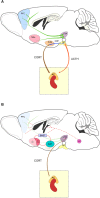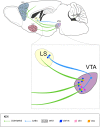Interaction Between Stress and Addiction: Contributions From Latin-American Neuroscience
- PMID: 30622500
- PMCID: PMC6308142
- DOI: 10.3389/fpsyg.2018.02639
Interaction Between Stress and Addiction: Contributions From Latin-American Neuroscience
Abstract
Drug addiction is a chronic neuropsychiatric disorder that escalates from an initial exposure to drugs of abuse, such as cocaine, cannabis, or heroin, to compulsive drug-seeking and intake, reduced ability to inhibit craving-induced behaviors, and repeated cycles of abstinence and relapse. It is well-known that chronic changes in the brain's reward system play an important role in the neurobiology of addiction. Notably, environmental factors such as acute or chronic stress affect this system, and increase the risk for drug consumption and relapse. Indeed, the HPA axis, the autonomic nervous system, and the extended amygdala, among other brain stress systems, interact with the brain's reward circuit involved in addictive behaviors. There has been a growing interest in studying the molecular, cellular, and behavioral mechanisms of stress and addiction in Latin-America over the last decade. Nonetheless, these contributions may not be as strongly acknowledged by the broad scientific audience as studies coming from developed countries. In this review, we compile for the first time a series of studies conducted by Latin American-based neuroscientists, who have devoted their careers to studying the interaction between stress and addiction, from a neurobiological and clinical perspective. Specific contributions about this interaction include the study of CRF receptors in the lateral septum, investigations on the neural mechanisms of cross-sensitization for psychostimulants and ethanol, the identification of the Wnt/β-catenin pathway as a critical neural substrate for stress and addiction, and the emergence of the cannabinoid system as a promising therapeutic target. We highlight animal and human studies, including for instance, reports coming from Latin American laboratories on single nucleotide polymorphisms in stress-related genes and potential biomarkers of vulnerability to addiction, that aim to bridge the knowledge from basic science to clinical research.
Keywords: CRF; Latin America; addiction; biomarkers; mesocorticolimbic pathway; stress.
Figures


Similar articles
-
Compulsive drug-seeking behavior and relapse. Neuroadaptation, stress, and conditioning factors.Ann N Y Acad Sci. 2001 Jun;937:1-26. doi: 10.1111/j.1749-6632.2001.tb03556.x. Ann N Y Acad Sci. 2001. PMID: 11458532 Review.
-
Neurobiology of addiction. Toward the development of new therapies.Ann N Y Acad Sci. 2000;909:170-85. doi: 10.1111/j.1749-6632.2000.tb06682.x. Ann N Y Acad Sci. 2000. PMID: 10911930 Review.
-
Addictions and stress: clues for cocaine pharmacotherapies.Curr Pharm Des. 2013;19(40):7065-80. doi: 10.2174/13816128113199990610. Curr Pharm Des. 2013. PMID: 23574443 Review.
-
[Cocaine and crack addiction: a growing public health problem].Bull Acad Natl Med. 2009 Apr;193(4):947-62; discussion 962-3. Bull Acad Natl Med. 2009. PMID: 20120283 French.
-
Neurobiology of addictive behaviors and its relationship to methadone maintenance.Mt Sinai J Med. 2000 Oct-Nov;67(5-6):375-80. Mt Sinai J Med. 2000. PMID: 11064487 Review.
Cited by
-
Development of a Cohesive Predictive Model for Substance Use Disorder Rehabilitation Using Passive Digital Biomarkers, Psychological Assessments, and Automated Facial Emotion Recognition: Protocol for a Prospective Cohort Study.JMIR Res Protoc. 2025 Jun 27;14:e71374. doi: 10.2196/71374. JMIR Res Protoc. 2025. PMID: 40577784 Free PMC article.
-
Peri-adolescent exposure to (meth)amphetamine in animal models.Int Rev Neurobiol. 2022;161:1-51. doi: 10.1016/bs.irn.2021.06.011. Epub 2021 Aug 20. Int Rev Neurobiol. 2022. PMID: 34801166 Free PMC article. Review.
-
Validation of the Turkish version of the Chronic Stress Scale: assessing social role-related stressors and their impact on psychopathology.Front Psychol. 2024 Dec 11;15:1479845. doi: 10.3389/fpsyg.2024.1479845. eCollection 2024. Front Psychol. 2024. PMID: 39726617 Free PMC article.
-
Abstinence from Escalation of Cocaine Intake Changes the microRNA Landscape in the Cortico-Accumbal Pathway.Biomedicines. 2023 May 5;11(5):1368. doi: 10.3390/biomedicines11051368. Biomedicines. 2023. PMID: 37239038 Free PMC article.
-
Promoting Healthy Behaviors in Older Adults to Optimize Health-Promoting Lifestyle: An Intervention Study.Int J Environ Res Public Health. 2023 Jan 16;20(2):1628. doi: 10.3390/ijerph20021628. Int J Environ Res Public Health. 2023. PMID: 36674395 Free PMC article.
References
Publication types
LinkOut - more resources
Full Text Sources

